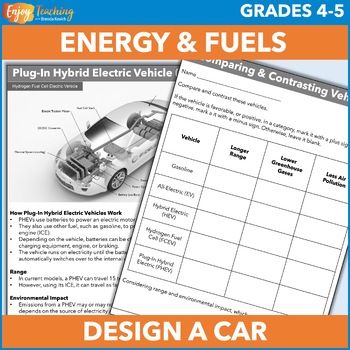Design a Car Project - Alternative/Renewable Fuels and Energy Use Activity
- PDF
- Easel Activity
What educators are saying
Also included in
- Six engaging science modules address fourth grade earth science standards for 30 states (NGSS and 10 others). Curriculum units include hands-on activities and projects; labs, stations, and experiments; STEM challenges; inquiry; and more. The following states and Washington, D.C. have adopted Next GePrice $25.60Original Price $32.00Save $6.40
- 23 engaging science modules address fourth grade science standards for 30 states (NGSS and 10 others). This full year of curriculum units includes hands-on activities, experiments, engineering design, and more.Open the previews to take a look at the standards-based units.The following states and WasPrice $97.20Original Price $121.50Save $24.30
- 25 engaging science modules address all new fourth grade Indiana Academic Standards for Science. A full year of curriculum units includes hands-on activities, experiments, engineering design, and more.This bundle addresses the intent of each standard and provides a variety of approaches to keep learPrice $105.20Original Price $131.50Save $26.30
- Looking for a variety of science activities to address your fifth grade Utah standards? Look no further! This bundle offers curriculum support for all standards: earth, physical, and life. Kids participate in hands-on labs, research projects, experiments, engineering design challenges, and more.OpenPrice $54.80Original Price $68.50Save $13.70
- Try two interdisciplinary projects for Earth Day! In the first science activity, fourth or fifth grade students compare fuel types and design their own eco-friendly vehicles. In the second, they read about and evaluate sources of electricity. As a result, your kids will become informed citizens!OpePrice $8.00Original Price $10.00Save $2.00
Description
Have some serious fun with cars and energy use! In this activity, students research or read about alternative (renewable) fuels and compare them. As a culmination to the project, they design their own “green” vehicles.
Open the preview to take a closer look.
First, kids learn about renewable and nonrenewable energy resources. A worksheet provides a quick review, and they categorize ten sources.
Second, they build background information. Before comparing alternative energy sources, students explore three one-page reference guides with concise context and supporting images. These pages can be used as handouts or anchor charts.
- Fossil fuels – Kids read how coal, oil, and natural gas formed from remains of ancient plants and animals.
- The greenhouse effect – They learn that this natural process traps heat necessary for life. Too much CO2, however, causes Earth’s temperature to rise slightly. In turn, this may disrupt natural balances.
- How electricity is generated – Most of the time, people use turbines to generate electrical energy. When the turbine spins, magnets push electrons along a coiled wire. At most power plants, the force of steam causes the turbine to rotate. Resources used to heat water. Then steam makes the turbines spin.
An exit ticket assesses their understanding of these science concepts.
Third, students learn about and compare five vehicle fuel types. Two options are included: self-driven research or reading informational text.
- Research – In groups or individually, students research gasoline, all-electric (EV), hybrid electric (HEV), fuel cell electric (FCEV), and plug-in hybrid electric (PHEV) vehicles. They discover how each car works, range, and environmental impact.
- Reading – As an alternative, they read a parallel one-page information sheet for each type.
Fourth, kids consider a real-life situation.
- They use engineering design terminology to define the problem, criteria, and constraints.
- Then they evaluate each vehicle to determine which provides longer range, lower greenhouse gases, and least air pollution.
- From their findings, they determine which car’s fuel type is most favorable.
As a grand finale (and engineering project), students design their own “green” vehicles.
Files include everything you need:
- Lesson plans
- Natural resources worksheet
- Background information on fossil fuels, the greenhouse effect, and how electricity is generated
- Exit ticket
- 5 vehicle research sheets - gasoline, all-electric (EV), hybrid electric (HEV), fuel cell electric (FCEV), plug-in hybrid electric (PHEV) vehicles
- 5 information sheets (same as above; can be used if skipping research or for answer keys)
- Engineering design focus page - asks kids to define the problem, as well as identify criteria and constraints
- Comparison table (kids compare range, greenhouse gases, and air pollution for each car)
- Design-your-own-vehicle activity
Resources can be used in a variety of ways.
- Earth Day exploration
- Science or STEM project
- ELA reading and writing activity
- Small group work
- Enrichment or gifted/talented (GATE) project
- Early or fast finishers activity
- Sub plans
- Homeschool
Your fourth or fifth grade students will love it – and you will too!
- Let’s face it, kids are interested in cars!
- Working independently or in groups engages them in science learning.
- Activities address the intent of your standards. For example, if you teach NGSS 4-ESS3-1, you can rest assured that students will “obtain and combine information to describe that energy and fuels are derived from natural resources and their uses affect the environment.”
Materials are included in three formats:
- Printable PDF
- Digital Easel Activities
- Digital Google Slides
Enjoy teaching!
Brenda Kovich











